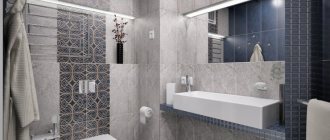We accept orders by phone or via mail [email protected]
Admin
+7
Renovation of apartments
Tile delivery
3D visualization
Menu
- home
- Select tiles Wall
- For floor
- For bathroom
- Mosaic
- For kitchen
- Porcelain tiles
- Glue
10.11.2016 23:00
Harmony of naturalness, simplicity of lines, grace and practicality, imbued with the enchanting appeal of antiquity and the magic of natural shades - all this is the Greek style in the interior, popular today in the decor of modern homes.
If the situation with living rooms is somewhat more complicated, then decorating a bathroom, hallway or kitchen in the Greek style will not be difficult. And ceramic tiles in the Greek style will help with this - an ideal finishing material with which you can decorate almost any surface, provide aesthetic appeal, practicality, safety and comfort.
Greek style. History of the legend
It is difficult to overestimate the influence of Greek civilization on the culture, socio-economic, and political formation of other peoples and states. The huge legacy left by the poets, sculptors, and philosophers of Ancient Greece still resonates in various spheres of human life and activity. The development of the ancient style took place in several stages. The influence of Egyptian traditions in the interior, which intensified in the 6th-4th centuries BC, gradually ennobled the elements of mythology inherent in early interiors. The decor becomes harmonious, luxury items take pride of place among the somewhat rustic furniture. Gradually the influence of the East becomes more and more obvious. After the conquest of Hellas by the Roman Empire, antiquity was partially assimilated and merged with the pomp and luxury of Roman art. However, practical Greeks do not change the simplicity and asceticism of centuries-old traditions. Such design solutions are also inherent in modern Greek style.
Greek style colors
Modern designers express the ancient Greek commitment to simplicity mainly through their color palette. The inhabitants of Ancient Hellas built their homes from natural materials - stone, wood. Therefore, in the Greek direction of the Mediterranean style, cold natural shades of sunny, white, and ivory predominate. Red or yellow color was used as an additional insert.
Granite and marble find a worthy place in the palette of Hellenic interiors. Blue color of various shades must be present, symbolizing the sea washing the shores of Greece. You can accent the central wall using marine motifs. I recommend finishing the perimeter of the room with textured plaster in natural shades.
Smooth wallpaper in bright colors is nonsense in Greek design. Against the background of strict accents of antique columns and symmetrical patterns, the enchanting palette looks out of place. Interspersed with red and brown tones with geometric patterns horizontally dividing the wall panels give the interior nobility and aristocratic sophistication. But here I would ask you to be especially careful. Accents should be used very sparingly.
The shine of mirrors arranged in vertical stripes will enhance the impression of spaciousness and expand the walls of the room. The palette is maintained throughout the entire volume of the room; drawings with Olympic motifs on the ceiling will help to emphasize the antiquity of the style.
As you may have already noticed, you can often see the traditional Greek meander in the decoration of rooms - a continuous complex geometric pattern, which is named after a river with a winding current.
Walls, floors, ceilings must have a matte surface. Smooth “soft” structures are not inherent in the style of the ancient Greeks.
What to choose?
Not sure what to choose from the huge variety of modern ceramic tiles and porcelain tiles? Take advantage of the help of our salon specialists. We will select ceramic tiles in the desired style for you, and also show you how to use them to create a unique interior that emphasizes your taste.
Call or email to consult with specialists and learn about all our salon offers!
Tags: Gardenia (Versace) , CAS , Vives , Tiles , Ceramic tiles , For walls , For floors , For kitchens , Porcelain tiles , Border , Imola Ceramica , Ethnics , Patchwork , Kerlife , Newker , Azulev , Dual Gres , Arabesque , Spanish Tiles , CAS Layal, Paisley, Newker Alhambra, Peronda Treasure, Dual Gres Paisley, Azulev Capuccino, Gardenia (Versace) Marble, Vives Aranjues, Turkish Cucumber, Kerlife Palace, Meander, Imola ceramic Via Veneto, Azulejo
Decorating the floor in a Greek interior
The apparent simplicity of the walls extends to the floor. The use of geometrically regular forms is characteristic of a later period, influenced by the Roman invasion. Geometric sophistication adds rigor to the entire room. Various materials are used. The mosaic surface is created using tiles of different sizes in natural colors. The floors of the rooms are laid out with squares of a calm palette. If space allows, I advise you to highlight the center of the room using a decorative pattern. It can be either strictly geometric or have a plot ornament.
Along the perimeter there are stripes of strict geometric patterns. The large area of the room intended for receiving guests will receive an aristocratic sound thanks to the use of the key ornament of Greek designers of antiquity: regular squares, broken using tiles of different sizes.
Ceramic tiles have been successfully replaced with wooden floors. The rich surface of the noble material creates additional comfort and puts the finishing touches on the interior. The warm climate of Greece completely excludes lush carpets underfoot. You can emphasize the style inherent in Greece by placing several small rugs with a traditional design. Porcelain stoneware floors and marine-style laminate will give the room a modern shine - an excellent solution that emphasizes the Mediterranean direction.
Lighting
The lighting in the room should be plentiful. The apartment has large windows; blinds are used extremely rarely. Sometimes Roman blinds are used, but it is better to give preference to tulles made of light fabric.
You should choose a stylized chandelier: with forging elements, in the form of a ball or hemisphere. Candle chandeliers in white and black colors look good.
If the room area is small, then one lamp in the center of the ceiling will be enough for optimal lighting. For large rooms, in addition to the main source of artificial light, it makes sense to choose interesting sconces, floor lamps or spotlights.
A chandelier with candles is a popular option for Greek design.
Furniture and materials
Furnishing rooms in the Greek style is akin to the customs of Ancient Sparta. Simplicity of form and laconic design are the fundamental rules in choosing tables and chairs. Regular geometric surfaces made of natural materials, the complete absence of velvet and leather in the decor will enhance the impression of being on the Mediterranean coast. Antique tables had a trapezoid shape, three strong bent legs turned in different directions - a stable base for tabletops in a Greek room. Chairs with low straight backs, made of natural materials, will help to stylize.
You need to remember: natural wicker furniture will negate the creation of an ancient Greek interior. The number of items should be minimal so as not to spoil the feeling of spaciousness characteristic of the natural style of Ancient Hellas. The facades of built-in wardrobes should not contain bright inserts; the presence of narrow vertically directed mirrors, on the contrary, will emphasize high ceilings and focus attention on the stylized finish. For relaxation, you can arrange a soft area, designed in the same color scheme.
Textile
In order for the textile design to correspond to the national color, it is selected from simple natural materials:
- square, oval or round shaped paths made of matting, matting or coarse hand-knitting are placed on the floor;
- beds and sofas are covered with plain bedspreads with a patterned edge;
- curtains are covered with white or light curtains (you can supplement them with blinds).
Greek style decor
Columns and pilasters are a necessary detail of the chosen interior. The elements will add an aristocratic gloss and enhance the feeling of spaciousness. In addition, the elements set the tone for the entire decor, the main task of which is to enhance the feeling of the height of the ceilings, thanks to the vertical orientation of the decorative structures. High ceilings suggest luxurious chandeliers, meander patterns will emphasize the height of the room. Columns mark the entrance and emphasize the size of the mirrors.
Repetition of elements, symmetry ─ the basic rule of the style of the ancient Greeks.
Symmetrically located figurines and antique vases will create “pomp and importance” - an axiom for creating room decor worthy of proud Hellenes. Small squares deny the very existence of Greek motifs. The color scheme of decorative details consists of cool natural shades. Yellow, gray, white tones are slightly “diluted” with splashes of red in the ornaments of frescoes depicting scenes from the life of Ancient Greece, tall amphorae painted with pictures of Olympic competitions.
Marble and granite appeared in the culture of the Greek Empire with the arrival of the Romans, who used the natural nobility of these materials. Hellas abandoned the use of gilding, so beloved by the conquerors. Oriental splendor ─ one of the signs of Mediterranean dwellings, which came with the development of trade, denies an overabundance of small details; all decorative elements used must be harmoniously combined, the palette should be kept in natural shades.
An important aspect of Greek decor is lighting. Textiles in the Mediterranean interior are used minimally. Open windows will make the colors, which are dull at first glance, sparkle in a special way, creating the impression of being at a seaside resort. The marine theme can be continued by using sea shells as decoration, placing them on the coffee table, in the recesses of small niches. Fabrics are used if it is necessary to drape small openings between windows. Vertical draperies in several layers will enhance the vertical direction of the interior.
When creating a Greek interior, it is necessary to remember restraint, conciseness and functionality of every detail, which is responsible for overall harmony.
When we talk about Greek style in interior design or clothing, we usually mean not modern Greece, but that period in the history of this state, which is called antiquity. Over the several thousand years of its existence, ancient Greek civilization did an incredible amount for the development of science and art. In Ancient Greece, culture and knowledge were given great importance. All modern science is based on the works of ancient Greek philosophers and mathematicians. And the works of sculptors, architects and artists of Ancient Greece are still considered examples of classical art.
The ancient Greeks, like no other people in the history of mankind, knew how to appreciate beauty. Beauty for them is harmony and order. The search for harmony, the desire to express the unity of form and content - this is what determined the development of ancient Greek art.
Interest in the achievements of ancient Greek civilization was revived towards the end of the last millennium. It was reflected in the formation of such styles as classicism and baroque. The influence of ancient Greek culture was very strong not only on theater, literature and painting, but also on architecture and design. In modern interiors, Greek themes also remain popular. Today we will tell you about creating a Greek interior in the bathroom.
Style Features
Quite often, the Greek style is confused with the wealth and luxury of the Roman style in design. And this is natural, because these two civilizations are very closely related to each other and have many similar features. But they should not be identified: the Greek style is characterized by restraint and elegance, while the Roman style is more “pompous”.
So, the main features of the interior in the Greek style:
- spacious rooms with high ceilings and large windows;
- frequent use of columns;
- the use of the national Greek ornament - meander loops as a decorative element;
- stucco molding on ceilings, columns and other structures;
- thematic frescoes on the walls;
- pastel color palette;
- minimum shine, including gilding;
- surface finishing with tiles made of natural or artificial marble;
- use of predominantly natural materials;
- copies of works of art by masters of Ancient Greece as decorative elements.
Walls
In addition to pastel colors and frescoes, the following techniques are used in wall decoration:
- The spacious room is decorated with white polyurethane columns, which are covered with several layers of paint (beige and white on top), then the edges are lightly rubbed. It gives the impression of natural stone or marble, aged by time.
- The living room is decorated with a fireplace. They cover it with patterned tiles or plain tiles.
- Arched niches are made in the walls. They can be left empty, or decorated with plants or sculpture.
- The walls are decorated with stone.
Who is it suitable for?
Greek style is one of the classic trends in design. It can be called universal, since the calm and nobility of this style is suitable for decorating a wide variety of rooms and is liked by a variety of people. However, there are categories of people who will especially like the Greek interior:
- Owners of spacious apartments in “Stalin” or new buildings, as well as those who live in country houses. In order for a Greek-style interior to look properly, large areas and high ceilings are required. Only in this case will the arched vaults and marble-clad columns look harmonious.
- Connoisseurs of the classics. If you are far from modern culture, then you are unlikely to like the latest trends in apartment design (such as loft or fusion). In this case, the simplicity and harmony of the Greek style, in which there is nothing superfluous and every thing has its place, is exactly your option.
Color solutions
Like any other room decorated in Greek style, the bathroom should be done in light colors. Since it is assumed that all surfaces in the room are lined with marble (even if in fact it is just an imitation of natural stone), white and similar tones will dominate in the interior: milky, cream, light beige, light lemon. A slight shade of blue is also allowed - after all, absolutely snow-white marble is practically never found in nature.
If you want to add some bright colors to a classic Greek interior, you can bring it closer to a more modern version of the Greek design direction - the Mediterranean style. It involves the use of bright, saturated, but not provocative colors - turquoise, coral, yellow, olive, green.
Greece is a country with an amazing history. She not only influenced the formation of the antique movement and contributed to the Mediterranean style, but also gave the world its own Greek style in the interior.
Features of the Greek style in the interior
Famous designers are happy to use the Greek style to create harmonious and intuitive interiors. This aesthetically attractive and graceful direction has a deep and meaningful philosophy.
Atmospheric interior design in Greek style
Characteristic features of the Greek style in the interior
The architects of Ancient Greece relied not only on the laws of physics and the principles of architecture, but also on the appearance of structures and the emotions they evoke. That is why interiors in the Greek style are very orderly and holistic. Their distinctive feature is a clear logic, which can be traced not only in the architecture, but also in the general design of the premises.
Harmonious interior design in Greek style
This direction, in contrast to the pompous Roman style, looks very neat and restrained. There is not a hint of excessive luxury or pretentiousness in it. Greek style looks best in spacious rooms. Large rooms combined with an open plan enhance the effect of freedom and volume. The focal point in an ancient Greek interior is the high ceiling, around which the rest of the design is built.
Open plan - the hallmark of the Greek style
Characteristic architectural elements of the Greek style are columns. They make it possible to raise the vaults even more, visually stretch the room vertically and give the interior a truly noble appearance. Neat columns and pilasters are perfect for visually adjusting rooms with insufficient ceiling heights. But beware of overly massive structures, as they hide the area and make the room smaller.
Greek interior layout using arches and columns
Greek style color scheme
The Greek style is dominated by a natural palette of shades. Use exclusively white as the base color, mixing it with accent colors. This design visually expands the space, making the interior more spacious.
Restrained colors of the Greek interior
The combination of white and blue is one of the most popular in the Greek style. Natural shades of wood, straw, clay, and olive leaves are added to these colors. The famous Greek patterns - meanders - are used to decorate the interior. They are found everywhere: in decoration, as prints on furniture upholstery, carpets, decorative textiles and dishes.
Fuchsia accents fit perfectly into the snow-white Greek interior
Features of finishing in the Greek style
When developing a project for a future interior, take into account the finishing features that are characteristic of the Greek style.
Authentic interior design in Greek style
Greek style walls
If you are going to embody the Greek style in the interior, you will have to give up wallpaper. The surface of the walls is covered with ordinary plaster, preferably with a rough texture, which will emphasize the authenticity of this direction.
Content
- Color spectrum
- Ceilings
- Walls
- Columns
- Floor
- Furniture
- Accessories
A characteristic feature of Greek interiors is majestic simplicity; they do not have pomp and luxury, an abundance of gilding and bright colors, as in the Roman style. But at the same time, all the elements look expensive, but discreet and elegant.
The simplicity of the Greek interior can be emphasized by choosing the right accent, for example, purple textile color
Interior decoration in Greek style
Greek style is incredibly versatile. Thanks to stylized furniture and decorative items, this trend can fit into almost any modern interior.
Cozy living room interior in Greek style
Greek style furniture
The main task in the process of interior design in the Greek style is not to overload the design. The minimalism of the furnishings is designed to maintain a feeling of spaciousness and freedom.
Minimalist interior in Greek style
Modern furniture in the Greek style looks very simple and laconic, while it is quite comfortable and functional. It is made of wood, complemented by cotton or linen upholstery.
Modern living room interior in Greek style
Greek-style furniture is never made from expensive materials. In this direction there is no place for brocade, silk, mahogany and rosewood. But unobtrusive products made from pine or oak will come in handy. The surface of wooden furniture is almost never painted, leaving the shade and texture of natural wood in its original form. A minimum of decoration is allowed, for example, forged overlays, carvings, artificial aging.
Charming interior of a dining room in Greek style
For a living room interior in a Greek style, it is worth purchasing a squat sofa, to which you can optionally add a couple of armchairs, a small buffet or wardrobe, or a coffee table made in somewhat primitive technology.
Attractive living room design in Greek style
A laconic wrought-iron or wooden bed with a simple headboard, decorated with a translucent canopy, would be appropriate in the bedroom. Since the Greek style strives for minimalism, you should not clutter the entire space with bedside tables and chests of drawers. It is best to replace them with open shelves.
Conceptual design of a bedroom in Greek style
A kitchen in the Greek style requires a simple kitchen set made of light wood, a roughly made dining group and antique-style plumbing fixtures. A minimal set of furniture in this room is the key to a correct understanding of the concept of direction.
Neat kitchen in Greek style











